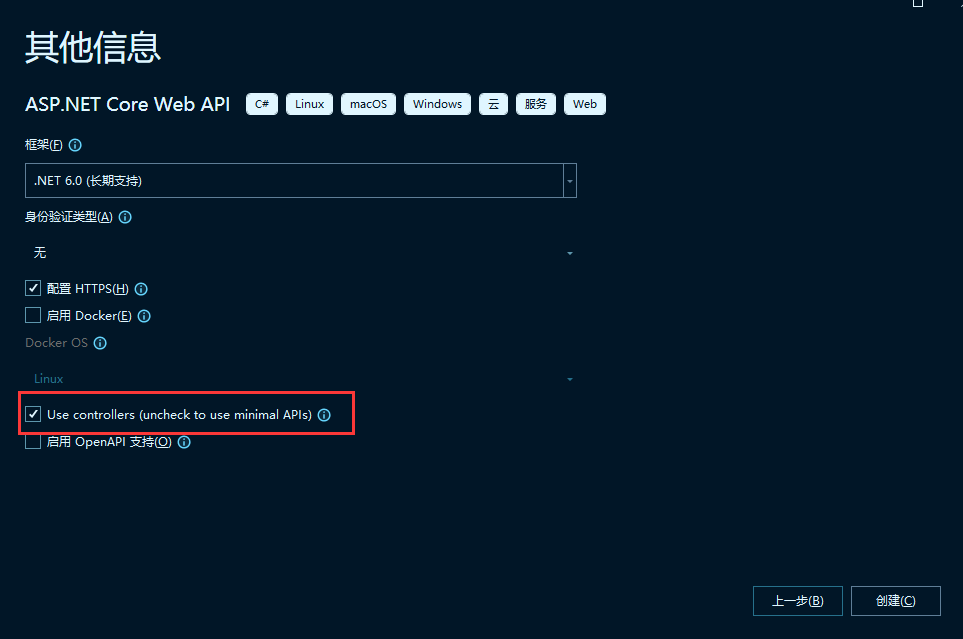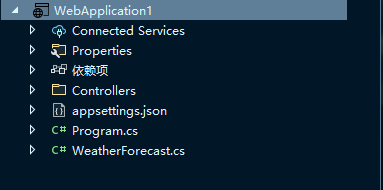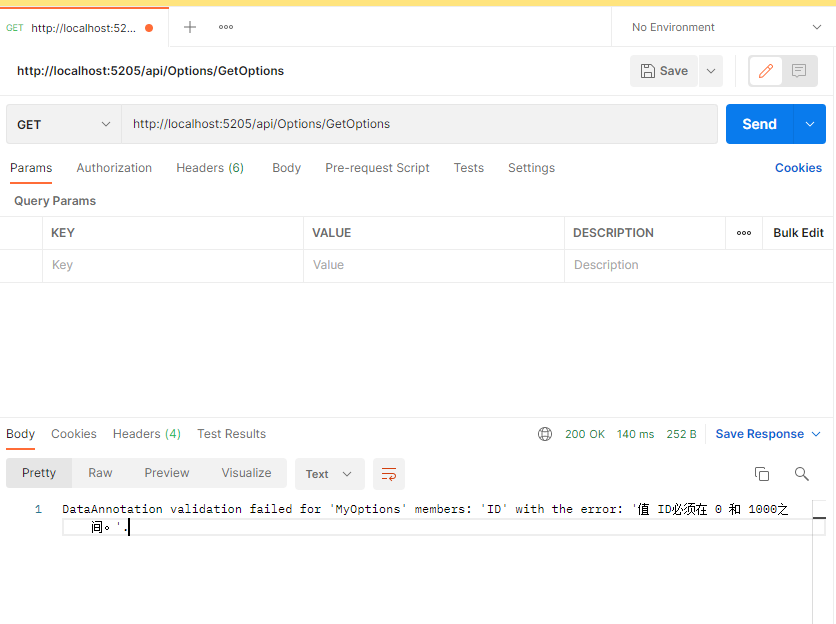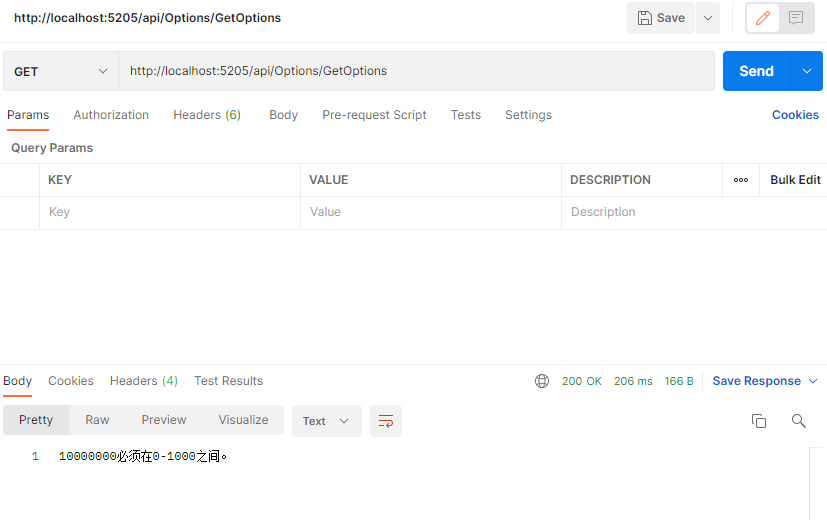前言
还记得上一篇文章中所说的配置吗?本篇文章算是上一篇的延续吧。在 .NET Core 中读取配置文件大多数会为配置选项绑定一个POCO(Plain Old CLR Object)对象,并通过依赖注入使用它。而这种使用方式称之为选项模式。而选项模式使是用类来提供对相关设置组的强类型访问,同时选项还提供验证配置数据的机制,是不是很强大,让我们一点点揭开它的神秘面纱。
ASP.NET Core 6.0 Web API简要说明
首先开发工具上需要VS2022了,这里非常推荐大家下载使用,在编码上真的越来越符合我们开发者的使用了,提示也更加智能化,VS2022详细说明,下载以及注册码可以参考我的上一篇博客,这里就不做详细说明了VS2022传送门(含注册码)。
.NET 6.0 已经出来有一段时间了,为了跟进技术的进步,笔者后续的系列笔记也将使用.NET 6.0作为目标框架,那么.NET 6.0 ASP.NET Core Web API 中带了了哪些变化呢?这里我做下简要说明。
- 打开Visual Studio 2022,创建新项目,选择“ASP.NET Core Web API”项目模板:

这里可以看见Use controllers选项默认选中的,取消该选项,则会创建最小Web API。 - 结构变化

这里可以看下Program.cs文件的变化
var builder = WebApplication.CreateBuilder(args);
// Add services to the container.
builder.Services.AddControllers();
var app = builder.Build();
// Configure the HTTP request pipeline.
app.UseHttpsRedirection();
app.UseAuthorization();
app.MapControllers();
app.Run();
可以发现我们熟知的Startup.cs不见了,现在,全部都在Program.cs中实现:
- 在WebApplicationBuilder实例上使用Addxxx方法向DI容器注册特定服务,类似Startup类的ConfigureServices方法实现。
- 在WebApplication实例上使用Usexxx方法将一系列中间件加入到HTTP管道,类似Startup类的Configure方法实现。
- DTO使用record定义,而且也放在同一个Program.cs文件中。
说明: Visual Studio 2022默认使用 Kestrel Web服务器,而不是IIS Express。
配置绑定
首先创建一个json格式的配置文件
{
"JsonConfig": {
"Title": "MyTitle",
"Name": "Tom"
}
}
创建选项类
public class MyOptions
{
public const string JsonConfig = "JsonConfig";
public string? Title { get; set; }
public string? Name { get; set; }
}
选项类说明:
- 必须是包含公共无参数构造函数的非抽象类。
- 类型的所有公共读写属性都已绑定。
- 不会绑定字段。 在上面的代码中,Position 未绑定。 由于使用了 Position 属性,因此在将类绑定到配置提供程序时,不需要在应用中对字符串 "Position" 进行硬编码。
使用 ConfigurationBinder 绑定
新建一个控制器来读取配置文件。
[Route("api/[controller]/[action]")]
[ApiController]
public class OptionsController : ControllerBase
{
private readonly IConfiguration _configuration;
public OptionsController(IConfiguration configuration)
{
_configuration=configuration;
}
public ContentResult GetOptions()
{
var options = new MyOptions();
//方式1
_configuration.GetSection(MyOptions.JsonConfig).Bind(options);
//方式2
_configuration.GetSection(MyOptions.JsonConfig).Get<MyOptions>();
return Content($"Title:{options.Title}\n Name:{options.Name}");
}
}
说明:
这里的类型绑定有两种方式分别为ConfigurationBinder.Bind 和 ConfigurationBinder.Get ,
前者相对于后者更方便一些,在开发过程当中比较推荐使用后者做类型绑定。
依赖注入绑定
服务容器中绑定配置。
using OptionsTest.Model;
var builder = WebApplication.CreateBuilder(args);
// Add services to the container.
builder.Services.AddControllers();
builder.Configuration.AddJsonFile("MyJsonConfig.json", optional: true, reloadOnChange: true);
//注入绑定
builder.Services.Configure<MyOptions>(builder.Configuration.GetSection(MyOptions.JsonConfig));
var app = builder.Build();
// Configure the HTTP request pipeline.
app.UseAuthorization();
app.MapControllers();
app.Run();
新建一个控制器来读取配置文件。
[Route("api/[controller]/[action]")]
[ApiController]
public class Options2Controller : ControllerBase
{
private readonly MyOptions _options;
public Options2Controller(IOptions<MyOptions> options)
{
_options = options.Value;
}
public ContentResult GetOptions()
{
return Content($"Title:{_options.Title}\n Name:{_options.Name}");
}
}
选项接口
IOptions
- 不支持:
- 在应用启动后读取配置数据。
- 命名选项
- 注册为单一实例且可以注入到任何服务生存期。
IOptionsSnapshot
- 在每次请求时应重新计算选项的方案中有用。 有关详细信息,请参阅使用 IOptionsSnapshot 读取已更新的数据。
- 注册为范围内,因此无法注入到单一实例服务。
- 支持命名选项
IOptionsMonitor
- 用于检索选项并管理 TOptions 实例的选项通知。
- 注册为单一实例且可以注入到任何服务生存期。
- 支持:
- 更改通知
- 命名选项
- 可重载配置
- 选择性选项失效 (IOptionsMonitorCache
)
IOptionsSnapshot
在项目中如何在改变配置文件后,在不重启项目的前提下自动加载配置文件呢?IOptionsSnapshot就支持读取已更新的配置值。
在前面项目的基础上略做改变就能做到,MyOptions.cs、MyJsonConfig.json、Program.cs不需要改变。在OptionsController中改用IOptionsSnapshot注入就可以了,代码如下:
[Route("api/[controller]/[action]")]
[ApiController]
public class Options2Controller : ControllerBase
{
private readonly MyOptions _options;
public Options2Controller(IOptionsSnapshot<MyOptions> options)
{
_options = options.Value;
}
public ContentResult GetOptions()
{
return Content($"Title:{_options.Title}\n Name:{_options.Name}");
}
}
是不是很简单,这样每次改完配置文件就不需要重启程序了。
IOptionsMonitor
MyOptions.cs、MyJsonConfig.json、Program.cs不需要改变。在OptionsController中改用IOptionsMonitor注入就可以了,代码如下:
[Route("api/[controller]/[action]")]
[ApiController]
public class OptionsController : ControllerBase
{
private readonly MyOptions _options;
public Options2Controller(IOptionsMonitor<MyOptions> options)
{
_options = options.Value;
}
public ContentResult GetOptions()
{
return Content($"Title:{_options.Title}\n Name:{_options.Name}");
}
}
说明:
IOptionsMonitor是一种单一示例服务,可随时检索当前选项值,这在单一实例依赖项中尤其有用。IOptionsSnapshot是一种作用域服务,并在构造IOptionsSnapshot对象时提供选项的快照。 选项快照旨在用于暂时性和有作用域的依赖项。
命名选项
命名选项:
- 当多个配置节绑定到同一属性时有用。
- 区分大小写。
新建json配置文件
{
"JsonConfig": {
"Title": "MyTitle",
"Name": "Tom"
},
"JsonConfig2": {
"Title": "MyTitle2",
"Name": "Jerry"
}
}
在属性相同的情况下,不需要创建两个类,我们增加一个字段就可以了。
public class MyOptions
{
public const string JsonConfig = "JsonConfig";
public const string JsonConfig2 = "JsonConfig2";
public string? Title { get; set; }
public string? Name { get; set; }
}
Program.cs中配置命名选项。
using OptionsTest3.Model;
var builder = WebApplication.CreateBuilder(args);
// Add services to the container.
builder.Services.AddControllers();
builder.Configuration.AddJsonFile("MyJsonConfig.json", optional: true, reloadOnChange: true);
//注入绑定
builder.Services.Configure<MyOptions>(MyOptions.JsonConfig,builder.Configuration.GetSection(MyOptions.JsonConfig));
builder.Services.Configure<MyOptions>(MyOptions.JsonConfig2, builder.Configuration.GetSection(MyOptions.JsonConfig2));
var app = builder.Build();
// Configure the HTTP request pipeline.
app.UseAuthorization();
app.MapControllers();
app.Run();
在Controller中读取配置。
[Route("api/[controller]/[action]")]
[ApiController]
public class Options3Controller : ControllerBase
{
private readonly MyOptions _options;
private readonly MyOptions _options2;
public Options3Controller(IOptionsSnapshot<MyOptions> options)
{
_options = options.Get(MyOptions.JsonConfig);
_options2 = options.Get(MyOptions.JsonConfig2);
}
public ContentResult GetOptions()
{
return Content($"Title:{_options.Title}\n Name:{_options.Name}\n" +
$"Title:{_options2.Title}\n Name:{_options2.Name}");
}
}
选项验证
在配置文件中对于配置项的验证是必不可少的。这样可以保证程序配置的正确性。具体如何实现呢,且听笔者慢慢道来。
首先创建一个简单的Json配置文件。
{
"JsonConfig": {
"ID": 10000000,
"Title": "MyTitle",
"Name": "Tom"
}
}
创建我们配置项的验证Model。
public class MyOptions
{
public const string JsonConfig = "JsonConfig";
[Range(0, 1000,
ErrorMessage = "值 {0}必须在 {1} 和 {2}之间。")]
public int ID { get; set; }
[RegularExpression(@"^[a-zA-Z''-'\s]{1,40}$")]
public string? Title { get; set; }
public string? Name { get; set; }
}
在Program.cs中配置我们的选项和验证。
using OptionValidtate.Model;
using System.Configuration;
var builder = WebApplication.CreateBuilder(args);
// Add services to the container.
builder.Services.AddControllers();
builder.Configuration.AddJsonFile("MyJsonConfig.json", optional: true, reloadOnChange: true);
builder.Services.AddOptions<MyOptions>().Bind(builder.Configuration.GetSection(MyOptions.JsonConfig)).ValidateDataAnnotations();
var app = builder.Build();
// Configure the HTTP request pipeline.
app.UseAuthorization();
app.MapControllers();
app.Run();
说明:注意到和之前的代码有什么不同了吗?在我们正是通过调用ValidateDataAnnotations 以使用 DataAnnotations 来完成验证。
在我们的Controller中读取我们的配置。这里用到了ILogger,可以先不用关心,在后续笔者会详细讲解。
[Route("api/[controller]/[action]")]
[ApiController]
public class OptionsController : ControllerBase
{
private readonly ILogger<OptionsController> _logger;
private readonly IOptions<MyOptions> _options;
public OptionsController(IOptions<MyOptions> options, ILogger<OptionsController> logger)
{
_options = options;
_logger = logger;
try
{
var optionsValue = _options.Value;
}
catch (OptionsValidationException e)
{
foreach (var failure in e.Failures)
{
_logger.LogError(failure);
}
}
}
public ContentResult GetOptions()
{
string msg;
try
{
msg=$"ID:{_options.Value.ID}\nTitle:{_options.Value.Title}\nName:{_options.Value.Name}\n";
}
catch (OptionsValidationException e)
{
return Content(e.Message);
}
return Content(msg);
}
}
还记得咱们配置的ID验证规则吗?启动程序看下我们的验证已经生效了。

IValidateOptions复杂验证的实现
如果上面的验证还不满足要求的话,没关系我对上面的代码略作修改,通过IValidateOptions就可以实现更加的复杂验证。
新建MyValidateOptions类继承IValidateOptions接口并实现。
public class MyValidateOptions : IValidateOptions<MyOptions>
{
public MyOptions _options { get; private set; }
public MyValidateOptions(IConfiguration config)
{
_options = config.GetSection(MyOptions.JsonConfig).Get<MyOptions>();
}
public ValidateOptionsResult Validate(string name, MyOptions options)
{
string msg = null;
var rxValidate = new Regex(@"^[a-zA-Z''-'\s]{1,40}$");
if (options.ID<0||options.ID>1000)
{
msg = $"{options.ID}必须在0-1000之间。";
}
if (string.IsNullOrEmpty(options.Title))
{
msg = $"{options.Title}必须符合正则要求。";
}
if (msg !=null)
{
return ValidateOptionsResult.Fail(msg);
}
return ValidateOptionsResult.Success;
}
}
在Program.cs中配置我们的选项和验证。
using Microsoft.Extensions.Options;
using OptionValidtate.Model;
using System.Configuration;
var builder = WebApplication.CreateBuilder(args);
// Add services to the container.
builder.Services.AddControllers();
builder.Configuration.AddJsonFile("MyJsonConfig.json", optional: true, reloadOnChange: true);
builder.Services.AddOptions<MyOptions>().Bind(builder.Configuration.GetSection(MyOptions.JsonConfig));
builder.Services.AddSingleton<IValidateOptions<MyOptions>,MyValidateOptions>();
var app = builder.Build();
// Configure the HTTP request pipeline.
app.UseAuthorization();
app.MapControllers();
app.Run();
好了配置完毕,运行程序可以看到我们配置的验证已经生效了。
